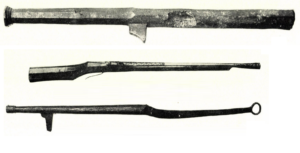The Long War, Part Eight

Summer 1594: The Siege of Esztergom, the death of Balassi Bálint
While General Teufenbach was trying to take Hatvan, the main Christian army, led by Archduke Habsburg Matthias was coming together at Győr. There were about 26-27,000 mercenaries and there were the south Trans-Danubian Region troops of György Zrínyi (7,000 men) as well as the forces of Nádasdy and Pálffy. Altogether, the number of the Imperial army which besieged Esztergom was about 35-40,000 soldiers. Here you can read more about Esztergom and its history, with many pictures of the fort as well:
https://www.hungarianottomanwars.com/ottoman-occupied-lands/esztergom/

They arrived at the fort at the beginning of May which was defended by Bey Kara Aliár and his aprx. 5,000 warriors. As the besiegers hadn’t surrounded the castle entirely, the Turks were able to get reinforcement from the Danube River. The Christian cannons were ruining the walls between 7-13 May and the soldiers have been launching attacks after this for two full weeks. The defenders were valiantly repelling these attacks.

The Christians could take the Rácváros (Serbian town) part of the city and the mounds of the Saint Thomas Hill by bloody fights but the defenders stopped all their advances. It happened on 19 May when one of these futile attacks was launched against the so-called Water Castle (it was the lower fort reaching down to the river) when Balassi Bálint got injured by a hook-gun. Ferdinand Hardegg ordered the assault too soon because the gap was not big enough yet. Yet, eight hundred German and Hungarian volunteers attacked the wall, and there were notable Hungarian aristocrats and noblemen like Nádasdy Ferenc, Pálffy Miklós, and Balassi Bálint among them. The defenders withstood the attack with unbelievable steadiness and killed 200 of the attackers who couldn’t get hold of the gap. Even Pálffy could get away only by hiding before a memorial stone. A bullet from a so-called hook gun caught both legs of Balassi, our greatest Renaissance warrior, and lyric poet. Although the bones were not hurt, he died because of the loss of blood and septic infection on 30 May. Allegedly, he refused the amputation of his legs for fear of not being able to ride a horse and fight against the Turks in the future.

Balassi wrote mostly in Hungarian but was also proficient in eight languages: Latin, Italian, German, Polish, Turkish, Slovak, Croatian, and Romanian. He is the founder of modern Hungarian lyric and erotic poetry. We know much about the famous Balassi Bálint but it is proper to commemorate his younger brother, Balassi Ferenc, who fell in the Battle of Monostorpály on 22 July 1594 when fighting the Crimean Tatars. You can read about Ferenc here:
https://www.hungarianottomanwars.com/essays/balassi-ferenc/

The Hungarians and the Germans have also suffered great losses because of the sallies of the defenders. The siege lasted for almost two months, without any results, mainly due to the mistakes of the besiegers. They had failed to take the fortifications in Párkány, on the left bank of the Danube River so they allowed to Turks to receive reinforcement by boat continuously. It was also a mistake to send the soldiers against the walls without having breached the walls properly. Thus, the siege of the castle of Esztergom was finished, and the Turks kept the fort. According to the sources: „The Turks cried down from the walls, saying: Hungarians, go home, you are valiant men but leave behind those drunken German pigs for us, let us teach them the art of war…”

On top of that, Archduke Matthias was not able to keep discipline in his camp, either. As Pasha Sinan had his army wintered in Hungary, his quick approach caused the end of the siege. Archduke Matthias crossed the Danube on 29 June with his army and withdrew to the Szigetköz area, near Győr City. His brother, Habsburg Maximilian was launching his attack in Croatia quite late, in July. His army of 14-16,000 men began to besiege Petrinja on 22 July. There, the Ottomans charged out one time and their leader, Bey Rusztán died in the fight. It was the reason why the defenders have surrendered the fort soon.
The Christians have taken Sziszek (Sisak) Castle back by the first part of August, along with several smaller forts like Hrasztovica and Gora. Having reached this much, Maximilian sent his soldiers home. He seemed to have done this too soon because the Bosnian Pasha took advantage of it and made a counter-attack, taking back all the three smaller forts, except Sziszek Castle.
The Imperial troops had to withdraw and they focused on the defense of Győr Castle.

Here is more about Sziszek (Sisak) Castle, where the whole war began after its sieges in 1591, 1592, and in 1593 in earnest:
https://www.hungarianottomanwars.com/kingdom-of-hungary/sziszek/
Dear Readers, I can only make this content available through small donations or by selling my books or T-shirts.
If you like my writings, please feel free to support me with a coffee here:
You can check out my books on Amazon or Draft2Digital, they are available in hardcover, paperback, or ebook:
https://www.amazon.com/dp/198020490X
or at https://books2read.com/b/boYd81


My work can also be followed and supported on Patreon: Become a Patron!http://Become a Patron!



